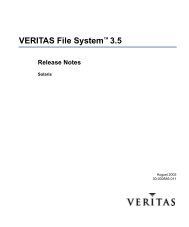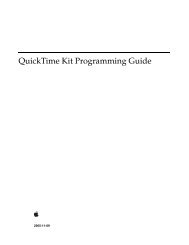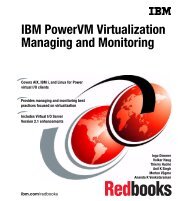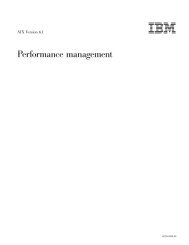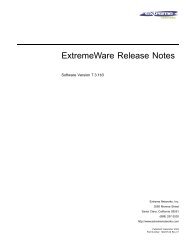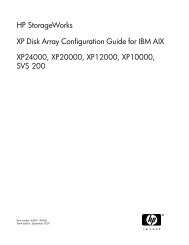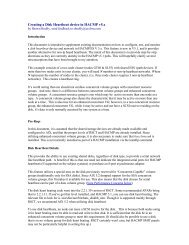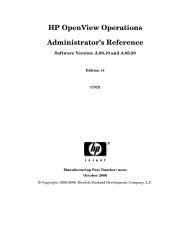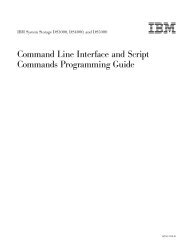HP-UX VxFS tuning and performance - filibeto.org
HP-UX VxFS tuning and performance - filibeto.org
HP-UX VxFS tuning and performance - filibeto.org
You also want an ePaper? Increase the reach of your titles
YUMPU automatically turns print PDFs into web optimized ePapers that Google loves.
24<br />
qio<br />
The qio option enables Veritas Quick I/O for Oracle database.<br />
Dynamic file system tunables<br />
File system <strong>performance</strong> can be impacted by a number of dynamic file system tunables. These values<br />
can be changed online using the vxtunefs(1M) comm<strong>and</strong>, or they can be set when the file system is<br />
mounted by placing the values in the /etc/vx/tunefstab file (see tunefstab(4)).<br />
Dynamic tunables that are not mentioned below should be left at the default.<br />
read_pref_io <strong>and</strong> read_nstream<br />
The read_pref_io <strong>and</strong> read_nstream tunables are used to configure read ahead through the buffer/file<br />
cache. These tunables have no impact with direct I/O or concurrent I/O. The default values are good<br />
for most implementations. However, read_pref_io should be configured to be greater than or equal to<br />
the most common application read size for sequential reads (excluding reads that are greater than or<br />
equal to the discovered_direct_iosz).<br />
Increasing the read_pref_io <strong>and</strong> read_nstream values can be helpful in some environments which can<br />
h<strong>and</strong>le the increased I/O load on the SAN environment, such as those environments with multiple<br />
fiber channel paths to the SAN to accommodate increased I/O b<strong>and</strong>width. However, use caution<br />
when increasing these values as <strong>performance</strong> can degrade if too much read ahead is done.<br />
write_pref_io <strong>and</strong> write_nstream<br />
The write_pref_io <strong>and</strong> write_nstream tunables are used to configure flush behind. These tunables have<br />
no impact with direct I/O or concurrent I/O. On <strong>HP</strong>-<strong>UX</strong> 11i v3, flush behind is disabled by default,<br />
but can be enabled with the system wide tunable fcache_fb_policy. On 11i v3, write_pref_io <strong>and</strong><br />
write_nstream should be set to be greater than or equal to read_pref_io <strong>and</strong> read_nstream,<br />
respectively.<br />
max_buf_data_size<br />
The max_buf_data_size is only valid for <strong>HP</strong>-<strong>UX</strong> 11i v2 or earlier. This tunable does not impact direct<br />
I/O or concurrent I/O. The only possible values are 8 (default) <strong>and</strong> 64. The default is good for most<br />
file systems, although file systems that are accessed with only sequential I/O will perform better if<br />
max_buf_data_size is set to 64. File systems should avoid setting max_buf_data_size to 64 if r<strong>and</strong>om<br />
I/Os are performed.<br />
Note<br />
Only tune max_buf_data_size to 64 if all file access in a file system will be<br />
sequential.<br />
max_direct_iosz<br />
This max_direct_iosz tunable controls the maximum physical I/O size that can be issued with direct<br />
I/O or concurrent I/O. The default value is 1 MB <strong>and</strong> is good for most file systems. If a direct I/O<br />
read or write request is greater than the max_direct_iosz, the request will be split into smaller I/O<br />
requests with a maximum size of max_direct_iosz <strong>and</strong> issued serially, which can negatively affect<br />
<strong>performance</strong> of the direct I/O request. Read or write requests greater than 1 MB may work better if<br />
max_direct_iosz is configured to be larger than the largest read or write request.



